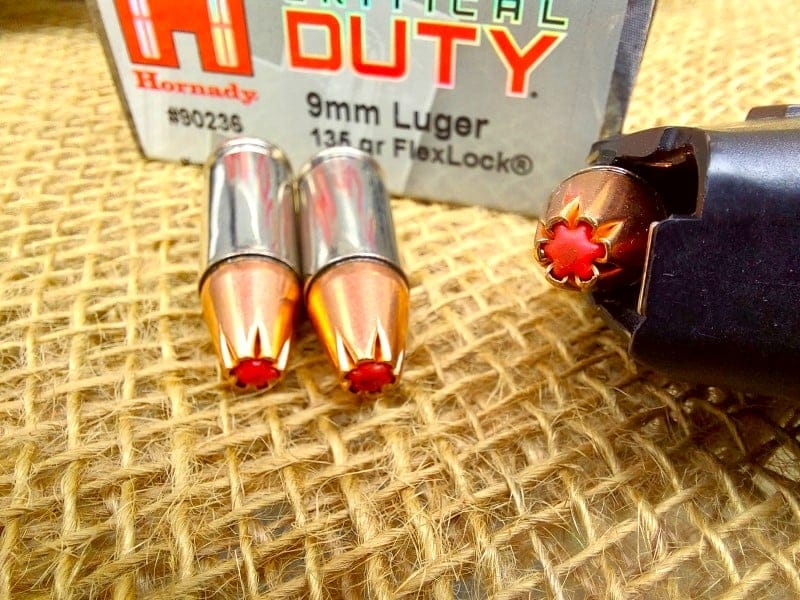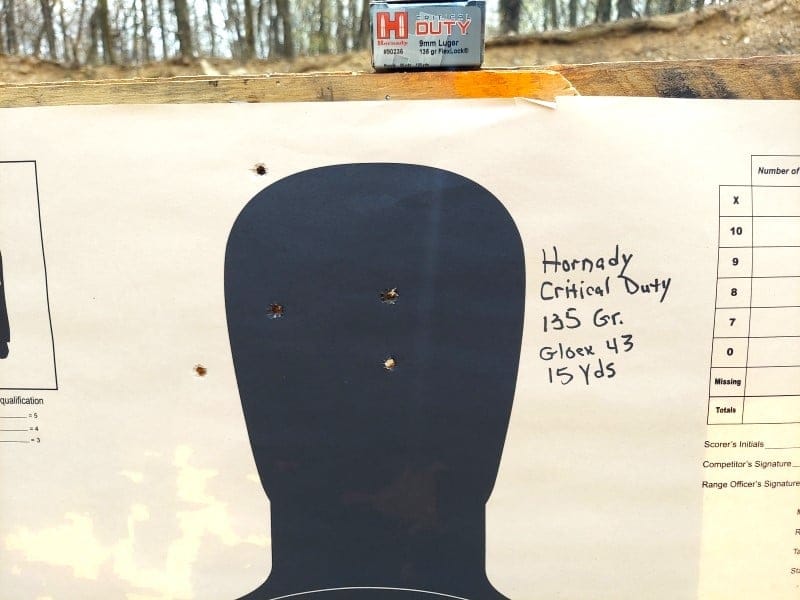Blasting away at the range during practice or training is one thing. Stuffing our magazines full of quality carry ammunition is quite another. When it comes to carry ammo for defense or duty, we want the very best that we can get ahold of. Today we’ll take a look at Hornady Critical Duty 9mm 135 Grain FlexLock ammunition to see how it performs.
Hornady Critical Duty FlexLock Features
First, let’s take a look at some of the features that distinguish Hornady Critical Duty FlexLock from other 9mm rounds.
Polymer Ball
Hornady’s FlexLock ammunition has a polymer ball in the nose of the bullet, which gets around issues that hollow points were sometimes experiencing when they would pass through barriers. Sometimes the barrier material would plug up the hollow cavity, causing it to fail to expand, in which case it would often act as a full metal jacket bullet.

Because the polymer ball is not compressible, it will force the bullet to expand, rather than act like a Full Metal Jacket round.
There is a jacket-to-core Interlock band that keeps the bullet’s jacket and core from separating, which helps to retain weight. Retained weight enables the bullet to penetrate deeply enough into targets to be effective at stopping bad guys.
Barrier Blind
Hornady states that this line of ammunition is “barrier blind,” in that it will still expand even when shot through common “urban barriers.”
The FBI’s protocol lists several barriers, and they include:
- Bare 10% ballistic gelatin.
- Auto glass (one piece, 15″x18″ ASI 1/4-inch laminated auto safety glass set at a 45° angle and 15 inches to the side).
- Sheet metal (two pieces of 20 gauge sheet steel, which replicates auto body metal).
- Heavy clothing (Four layers total: two layers of cotton t-shirt material, one layer of Polartec fleece, and one layer of cotton denim).
- Wallboard (two pieces of standard 1/2-inch gypsum spaced 3.5 inches apart).
- Plywood (one piece, 3/4-inch).
After penetrating these mediums, the bullets still have to penetrate the FBI’s protocol of 12-18 inches of 10% ballistic gelatin. For the barrier tests, that gelatin is clothed in simulated light clothing (cotton t-shirt and dress shirt materials).
That’s one hell of a tall order for a handgun bullet to accomplish! But Hornady seems to have done it. To be honest, just hearing the requirements, I’d have serious doubts that any bullet could realistically accomplish all of this, but it has been demonstrated and proven. I find it simply amazing what can be done with modern bullets.
Let me make a confession here: I did not test these rounds ballistically in gelatin or any other medium. The FBI has millions of dollars at their disposal, as does Hornady. I could never hope to even get close to matching their tests, and so I’m content to see how the rounds feed through my firearms and call it a day. I believe the Hornady and FBI tests are legitimate.
Nickel-Plated Cases
Nickel-plated cases are used because it makes chamber checks easier (the nickel reflects light more efficiently). Nickel plating will also facilitate better feeding and extraction of cases through the chamber.
Low Flash Propellant
In order to preserve shooters’ night vision, low-flash propellants are used in the Critical Duty rounds. I’ve never noticed any flash from these rounds, although I’ve not fired them in darkness.
Is it Hollow Point?
Nowadays, there are a few states, such as New Jersey, that prohibit their citizens from carrying hollow point ammunition. One can have hollow points in one’s home there, but not when they’re out and about in public.

Critical Duty ammunition, however, has that polymer ball in the tip of the bullet. It’s not an open cavity. Consequently, it appears that this is not hollow point ammunition. So people in New Jersey can avail themselves of a very high-quality type of ammunition while getting around the hollow point prohibition.
Disclaimer: I checked on this at the time of writing. Do not assume, as you read this, that the laws are still the same. It behooves the reader to do his or her own check of the laws. Remember — it’s YOUR freedom that is at stake!
Range Time With the Critical Duty Ammo
So how did this ammo stack up at the range?

I think it did very well! My test gun was a Glock 43. It fed the ammo perfectly, which was not a surprise.
Accuracy was… well, the ammo was more accurate than your author. At 15 yards, I fired a rapid-fire group at the head of the target, which I believe was representative of the day’s groups. You can see, from the accompanying photographs, how I made out.

Recoil was mild and it was easy to keep the pistol on target, even though it was a compact pistol. I did not notice any muzzle flash at all (not surprising, as it was daylight).
The Verdict
I love Hornady Critical Duty Defense ammunition. I’ve used it in a couple of different pistols, including my Glock 43 and a Sig P238 (in .380 ACP). It works well and I foresee getting more of this ammo to carry on a regular basis.
As I write this, it sells for $32.99 per box at GunMag Warehouse. That’s comparable to most high-quality defensive/duty ammunition on the market, and it comes in a 25-round box, which is more bullets than most.
Given the exhaustive testing that the FBI has put this ammunition through and the resulting performance, I don’t think there’s any ammo on the market that can beat its performance.


